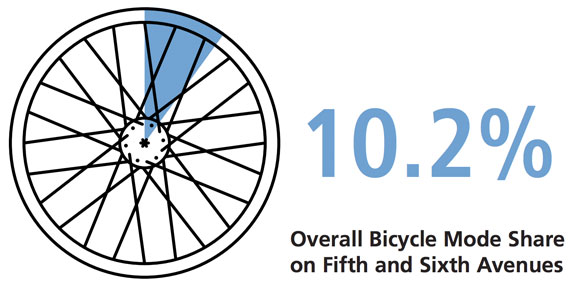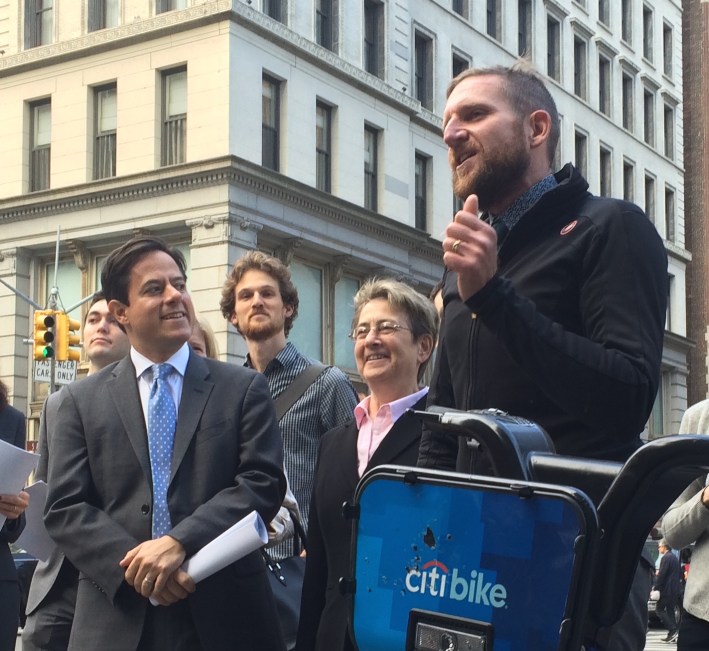
Last month DOT announced its intent to add a protected bike lane along 19 blocks of Sixth Avenue. A coalition of advocates, business groups, community board representatives, and elected officials think the city can do better. At a press conference next to the Flatiron Building this morning, they called on DOT to redesign the entire length of Fifth Avenue and Sixth Avenue in Manhattan.

In a report released today, Transportation Alternatives makes the case for protected lanes on both avenues [PDF]. Protection is needed for the large number of people who already bike on these streets, with cyclists comprising up to one in six vehicles on Fifth Avenue south of 23rd Street, according to TA. Protected bike lanes and pedestrian islands are proven to improve safety for everyone who uses the street. The share of women biking is also higher on avenues where protected lanes have been installed, TA said.
"We're here today to commend the Department of Transportation and Mayor de Blasio for committing to a complete street redesign on Sixth Avenue between 14th and 33rd streets, but we're also here today to encourage them to do much more," said TA Executive Director Paul Steely White. "It's just irresponsible to have so many cyclists on a main thoroughfare with no protection whatsoever."
"[We] have been asking for a while that the Department of Transportation make this entire area a bicycle network, so that you don't simply have to avoid certain avenues because you're afraid you may be hit or injured," said Council Member Corey Johnson.
TA conducted traffic counts between April and August, gathering a total of 32 hours of data. Cyclists comprise 10 percent of vehicle traffic on Fifth and Sixth. Bike-share accounts for 26 percent of that bike traffic -- more during morning and evening rush hours.
"The numbers do not lie," said City Council Member Dan Garodnick. "Fifth and Sixth avenues are important corridors for the city and they are important corridors for bicyclists."
Counts on both avenues at 38th Street revealed that women accounted for 10 percent of cyclists. TA reports that the share of female riders is twice as high -- 20 percent -- on First Avenue and Ninth Avenue, which have protected bike lanes.
When DOT announced that it would begin planning for a northbound protected bike lane on Sixth between 14th and 33rd streets, the agency said southbound cyclists wanting a protected lane could use Broadway. "When I ride my bike on Broadway, I'm always getting off and walking my bike," White said. "The pedestrian volumes are such that people are spilling into the bike lane on Broadway. If you want an expeditious route, you have to use Fifth... Cyclists are already using Fifth Avenue, and they're only going to use it more."
Commissioner Polly Trottenberg also said at last month's announcement that protected lanes in Midtown would proceed "one step at a time," with DOT looking "to work our way north, as we have on a lot of these projects.”
Dan Rivoli of the Daily News asked what TA thought of City Hall's overall track record on bike lanes. "I'd say it's mixed," White said. "We're still working on the mayor. We're still encouraging him to make that goal of doubling bicycling as prominent as some of the other goals of his administration."
On the other hand, White said, "I think it's safe to say, if you could do a protected bike lane on Queens Boulevard, you could do it anywhere." The Queens Boulevard bike lane primarily used buffer space already on the street, however, and did not require much reallocation of space from moving cars to bicycles and pedestrians.
I asked White if he's satisfied with City Hall's commitment to reclaiming street space from the automobile. "I think we're getting there," he said, before mentioning a long-anticipated plan on the Upper West Side. "Amsterdam is going to be an interesting project to watch, because by most accounts that project will require the repurposing of one car lane to give pedestrians and bikers more space."
"For years, the city has had a goal of speeding traffic, and what we've seen is that has made our streets less safe. Slowing down, having lower speed limits, is a positive," said Assembly Member Deborah Glick. "While there may be some frustration on the part of some drivers, maybe that will encourage them to get out of their cars."





